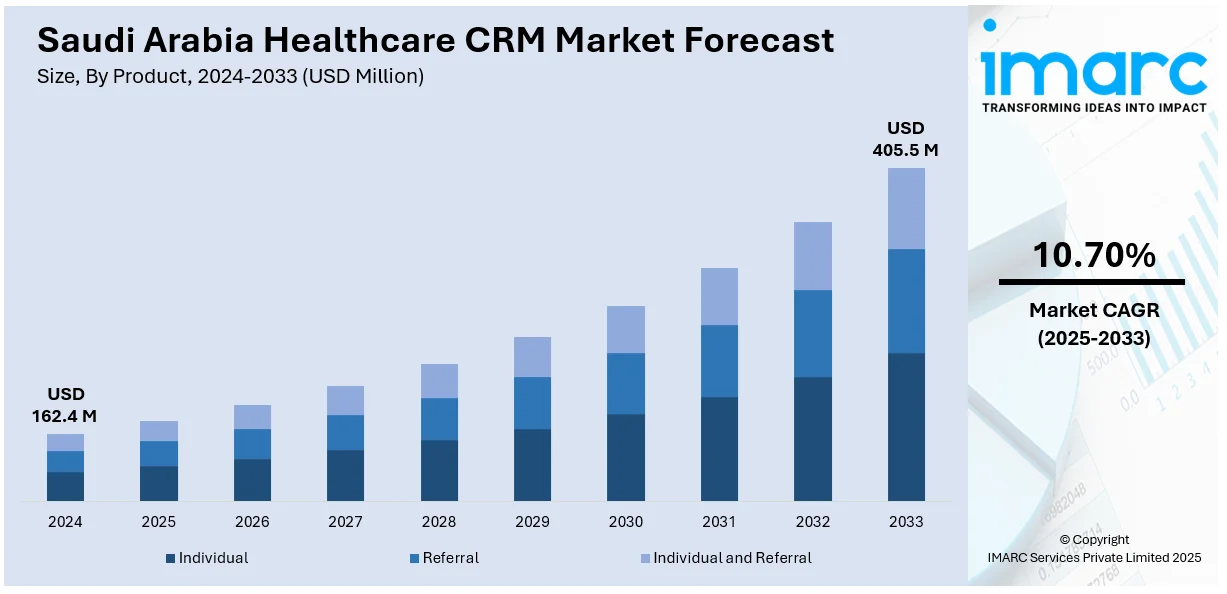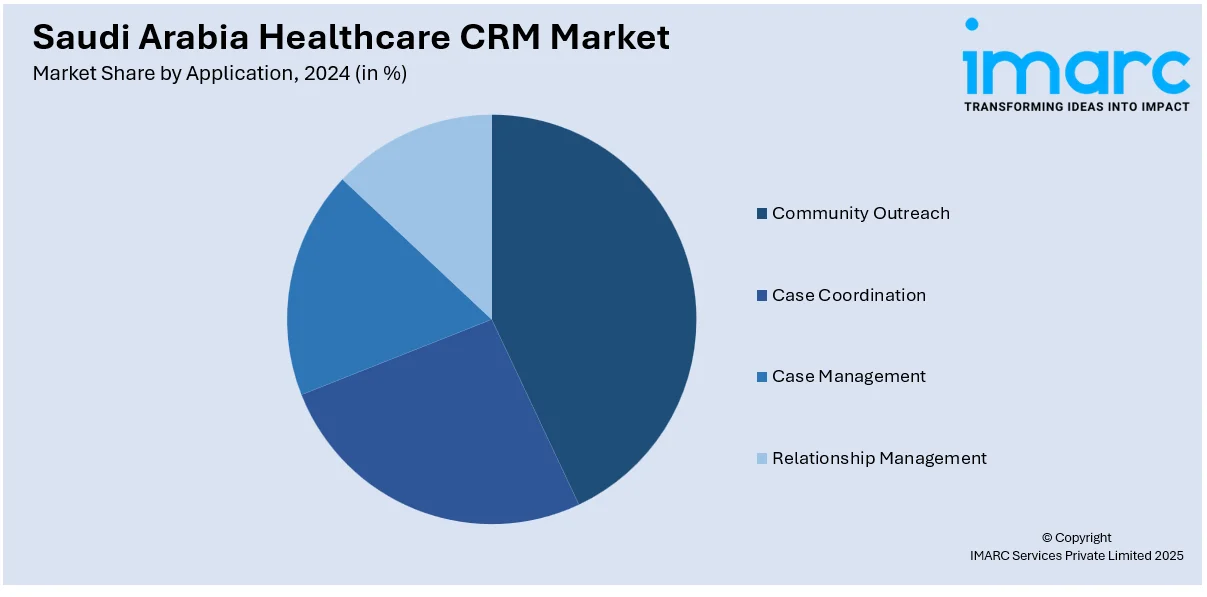
Saudi Arabia Healthcare CRM Market Size, Share, Trends and Forecast by Product, Application, Technology, End Use, and Region, 2025-2033
Saudi Arabia Healthcare CRM Market Overview:
The Saudi Arabia healthcare CRM market size reached USD 162.4 Million in 2024. Looking forward, IMARC Group expects the market to reach USD 405.5 Million by 2033, exhibiting a growth rate (CAGR) of 10.70% during 2025-2033. The market share is expanding, driven by the growing focus of the government on diversifying the economy and strengthening public service sectors, heightened movement toward patient-centered care, and increasing use of emerging technologies like artificial intelligence (AI) and machine learning (ML).
|
Report Attribute
|
Key Statistics
|
|---|---|
|
Base Year
|
2024
|
|
Forecast Years
|
2025-2033
|
|
Historical Years
|
2019-2024
|
| Market Size in 2024 | USD 162.4 Million |
| Market Forecast in 2033 | USD 405.5 Million |
| Market Growth Rate 2025-2033 | 10.70% |
Saudi Arabia Healthcare CRM Market Trends:
Government Initiatives and Vision 2030
The Vision 2030 initiative of the Saudi government focuses on diversifying the economy and strengthening public service sectors, such as healthcare. The core of this vision is the digitalization of healthcare services with a focus on the implementation of cutting-edge technologies to enhance patient care and efficiency in operations. This strategic initiative is resulting in more investments in healthcare information technology (IT) infrastructure, such as customer relationship management (CRM) systems, to support enhanced patient management and interaction. By giving precedence to digital health solutions, the government is fostering an environment conducive to the large-scale adoption of healthcare CRM platforms, making it possible for healthcare providers to provide more personalized and efficient services to patients. As per an article issued by U.S. Chamber of Commerce in 2024, Under Vision 2030, the government of Saudi Arabia will invest over $65 billion in healthcare and increase private sector contribution from 40% to 65%. Moreover, the Ministry of Health expects over 100 new public-private partnerships in the healthcare industry with private sector investment of $12.8 billion over the next five years (2022-2027).

Growing Emphasis on Patient-Centric Care
There is movement toward patient-centered care, and Saudi Arabia is joining in by concentrating on improving patient outcomes and experiences. Healthcare CRM technology plays a major role in the process by helping providers gather and analyze in-depth patient information, monitor interactions, and tailor messages. This all results in more engaged, satisfied, and loyal patients. Through the use of CRM tools, healthcare organizations are able to gain better insights into patient needs and preferences, enabling them to deliver more personalized healthcare services and create a more collaborative patient-provider relationship. In 2025, the Ministry of Health in Saudi Arabia unveiled the “Jam Artificial Intelligence” initiative or providing healthcare quality for aged population and women. This initiative is aimed at focusing on creating innovative solutions, addressing various challenges related to healthcare, and deploying modern tools and methodologies.
Integration of Advanced Technologies
The use of emerging technologies like machine learning (ML) and artificial intelligence (AI) in healthcare CRM systems is transforming the Saudi Arabian healthcare industry. AI and ML increase the functionality of CRM platforms by enabling predictive analytics, automating mundane tasks, and giving access to more insight about patient behaviors and trends. Not only do they increase operational efficiency but also allow healthcare providers to provide proactive and personalized care. Additionally, integration of cloud computing and Internet of Things (IoT) enables sharing of real-time data between departments, enhancing coordination and continuity of care. This technological advancement supports Saudi Arabia's Vision 2030 strategy, which encourages digital transformation in healthcare as a path to attaining better standards of service delivery. The Saudi Arabia healthcare cloud computing market size is expected to reach USD 1,196.0 Million by 2033.
Saudi Arabia Healthcare CRM Market Segmentation:
IMARC Group provides an analysis of the key trends in each segment of the market, along with forecasts at the region level for 2025-2033. Our report has categorized the market based on product, application, technology, and end use.
Product Insights:
- Individual
- Referral
- Individual and Referral
The report has provided a detailed breakup and analysis of the market based on the product. This includes individual, referral, and individual and referral.
Application Insights:

- Community Outreach
- Case Coordination
- Case Management
- Relationship Management
A detailed breakup and analysis of the market based on the application have also been provided in the report. This includes community outreach, case coordination, case management, and relationship management.
Technology Insights:
- Cloud-based
- Mobile
- Social
- Collaborative
- Predictive
A detailed breakup and analysis of the market based on the technology have also been provided in the report. This includes cloud-based, mobile, social, collaborative, and predictive.
End Use Insights:
- Payers
- Providers
- Life Science Companies
A detailed breakup and analysis of the market based on the end use have also been provided in the report. This includes payers, providers, and life science companies.
Regional Insights:
- Northern and Central Region
- Western Region
- Eastern Region
- Southern Region
The report has also provided a comprehensive analysis of all the major regional markets, which include northern and central region, western region, eastern region, and southern region.
Competitive Landscape:
The market research report has also provided a comprehensive analysis of the competitive landscape. Competitive analysis such as market structure, key player positioning, top winning strategies, competitive dashboard, and company evaluation quadrant has been covered in the report. Also, detailed profiles of all major companies have been provided.
Saudi Arabia Healthcare CRM Market Report Coverage:
| Report Features | Details |
|---|---|
| Base Year of the Analysis | 2024 |
| Historical Period | 2019-2024 |
| Forecast Period | 2025-2033 |
| Units | Million USD |
| Scope of the Report |
Exploration of Historical Trends and Market Outlook, Industry Catalysts and Challenges, Segment-Wise Historical and Future Market Assessment:
|
| Products Covered | Individual, Referral, Individual and Referral |
| Applications Covered | Community Outreach, Case Coordination, Case Management, Relationship Management |
| Technologies Covered | Cloud-based, Mobile, Social, Collaborative, Predictive |
| End Uses Covered | Payers, Providers, Life Science Companies |
| Regions Covered | Northern and Central Region, Western Region, Eastern Region, Southern Region |
| Customization Scope | 10% Free Customization |
| Post-Sale Analyst Support | 10-12 Weeks |
| Delivery Format | PDF and Excel through Email (We can also provide the editable version of the report in PPT/Word format on special request) |
Key Questions Answered in This Report:
- How has the Saudi Arabia healthcare CRM market performed so far and how will it perform in the coming years?
- What is the breakup of the Saudi Arabia healthcare CRM market on the basis of product?
- What is the breakup of the Saudi Arabia healthcare CRM market on the basis of application?
- What is the breakup of the Saudi Arabia healthcare CRM market on the basis of technology?
- What is the breakup of the Saudi Arabia healthcare CRM market on the basis of end user?
- What is the breakup of the Saudi Arabia healthcare CRM market on the basis of region?
- What are the various stages in the value chain of the Saudi Arabia healthcare CRM market?
- What are the key driving factors and challenges in the Saudi Arabia healthcare CRM?
- What is the structure of the Saudi Arabia healthcare CRM market and who are the key players?
- What is the degree of competition in the Saudi Arabia healthcare CRM market?
Key Benefits for Stakeholders:
- IMARC’s industry report offers a comprehensive quantitative analysis of various market segments, historical and current market trends, market forecasts, and dynamics of the Saudi Arabia healthcare CRM market from 2019-2033.
- The research report provides the latest information on the market drivers, challenges, and opportunities in the Saudi Arabia healthcare CRM market.
- Porter's five forces analysis assist stakeholders in assessing the impact of new entrants, competitive rivalry, supplier power, buyer power, and the threat of substitution. It helps stakeholders to analyze the level of competition within the Saudi Arabia healthcare CRM industry and its attractiveness.
- Competitive landscape allows stakeholders to understand their competitive environment and provides an insight into the current positions of key players in the market.
Need more help?
- Speak to our experienced analysts for insights on the current market scenarios.
- Include additional segments and countries to customize the report as per your requirement.
- Gain an unparalleled competitive advantage in your domain by understanding how to utilize the report and positively impacting your operations and revenue.
- For further assistance, please connect with our analysts.
 Request Customization
Request Customization
 Speak to an Analyst
Speak to an Analyst
 Request Brochure
Request Brochure
 Inquire Before Buying
Inquire Before Buying




.webp)




.webp)












